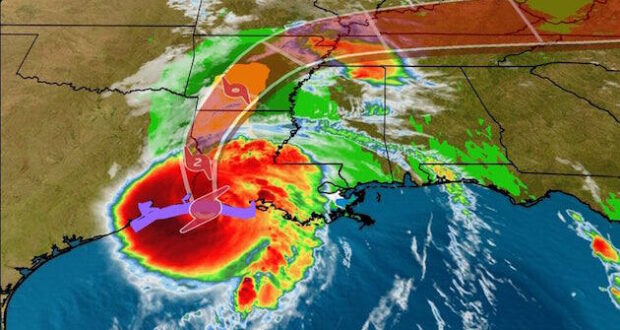Lake Charles, Louisiana was shredded by hurricane Laura as she roared ashore along the Gulf Coast overnight. The storm pounding residents who remained with a life-threatening sea surge, wind and historic rain. Videos (below) showed the city’s skyscrapers severely damaged by ferocious winds.
Thursday morning, damage has not yet been fully realized but authorities believe it to be devastating along the coast. Many roads remain impassable from trees and debris or high water.
NEW: buildings completely gutted, glass falling everywhere in downtown Lake Charles, LA in the eye of #HurricaneLaura @RadarOmega_WX pic.twitter.com/o1nkGLgUiB
— Reed Timmer, PhD (@ReedTimmerUSA) August 27, 2020
Videos on social media showed Laura’s winds battering a tall building in Lake Charles, blowing out windows as glass and debris flew to the ground.
“There are some people still in town and people are calling … but there ain’t no way to get to them,” Tony Guillory, president of the Calcasieu Parish Police Jury, said early Thursday morning over the phone as he hunkered down in a Lake Charles government building that was shaking from the storm.
Guillory said he hopes stranded people can be rescued later Thursday but fears that blocked roads, downed power lines and flooding could get in the way. Officials said search missions and damage assessments would begin when conditions allow it.
With more than 290,000 homes and businesses without power in the two states, near-constant lightning provided the only light for some.
The National Hurricane Center said Laura intensified rapidly before plowing into land with sustained winds of 150 mph (241 kph) at 1 a.m. CDT as a Category 4 hurricane near Cameron, a 400-person community about 30 miles (48 kilometers) east of the Texas border.
“Unsurvivable storm surge with large and destructive waves will cause catastrophic damage,” forecasters warned. They said the storm surge could reach 15-20 feet in Port Arthur, Texas, and a stretch of Louisiana including Lake Charles.
“This surge could penetrate up to 40 miles inland from the immediate coastline, and flood waters will not fully recede for several days,” the hurricane center said.
Nearly five hours after landfall, Laura was downgraded to a Category 2 hurricane, with maximum sustained winds of 110 mph (175 kph). Forecasters say it’s centered about 45 miles (70 kilometers) north-northwest of Lake Charles and moving north at 15 mph (24 kph), but with damaging winds that stretched over much of Louisiana and parts of eastern Texas.
More than 580,000 coastal residents were under orders to flee in the largest evacuation since the coronavirus pandemic began and many did, filling hotels and sleeping in cars since officials didn’t want to open mass shelters and worsen the spread of COVID-19.
But in Cameron Parish, where Laura came ashore, officials said at least 150 people refused pleas to leave and planned to weather the storm in everything from elevated homes to recreational vehicles. The result could be deadly since forecasters said the parish could be completely covered by ocean water.
“It’s a very sad situation,” said Ashley Buller, assistant director of emergency preparedness. “We did everything we could to encourage them to leave.”
Becky Clements, 56, didn’t take chances; she evacuated from Lake Charles after hearing that it could take a direct hit. With memories of the destruction almost 15 years ago by Hurricane Rita, she and her family found an Airbnb hundreds of miles inland.
“The devastation afterward in our town and that whole corner of the state was just awful,” Clements recalled Wednesday. “Whole communities were washed away, never to exist again.”
Forecasters expected a weakened Laura to move northward through Louisiana and cause widespread flash flooding in states far from the coast. After turning eastward and reaching the Atlantic Ocean, it could again become a tropical storm and threaten the Northeast.
Laura hit the U.S. after killing nearly two dozen people on the island of Hispaniola, including 20 in Haiti and three in the Dominican Republic, where it knocked out power and caused intense flooding.
Laura was the seventh named storm to strike the U.S. this year, setting a new record for U.S. landfalls by the end of August. The old record was six in 1886 and 1916, according to Colorado State University hurricane researcher Phil Klotzbach.
–Wire services
 Metro Voice News Celebrating Faith, Family & Community
Metro Voice News Celebrating Faith, Family & Community









